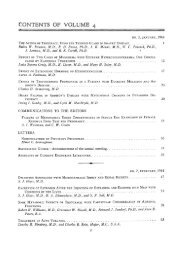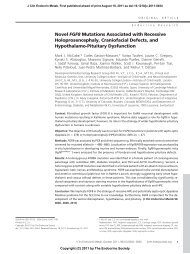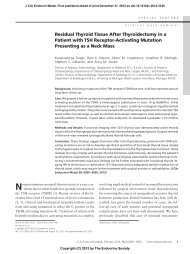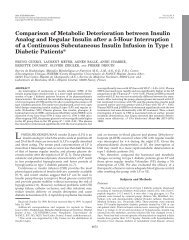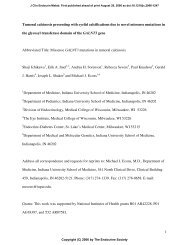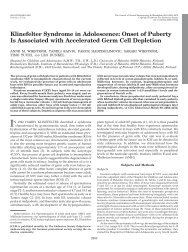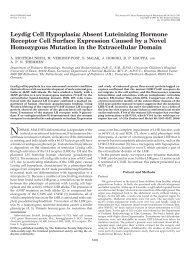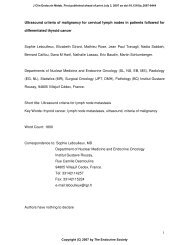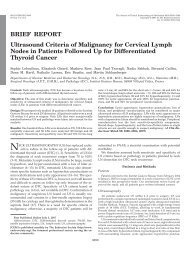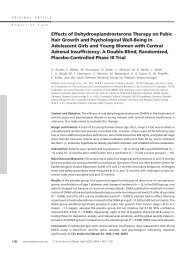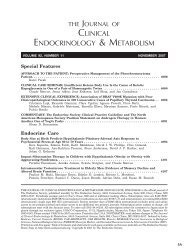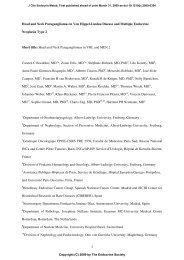The Effects Of Exercise-Induced Weight Loss On - The Journal of ...
The Effects Of Exercise-Induced Weight Loss On - The Journal of ...
The Effects Of Exercise-Induced Weight Loss On - The Journal of ...
Create successful ePaper yourself
Turn your PDF publications into a flip-book with our unique Google optimized e-Paper software.
1610 Martins et al. <strong>Exercise</strong> and Appetite Control J Clin Endocrinol Metab, April 2010, 95(4):1609–1616<br />
cise increase their eating and do not lose as much weight<br />
as expected” (4). It is generally accepted that the appetite<br />
regulatory system will quickly defend impositions that<br />
promote a negative energy balance (EB). Metabolic and<br />
behavioral compensatory responses, targeting both sides<br />
<strong>of</strong> the EB equation, are likely to influence the magnitude<br />
<strong>of</strong> weight loss in response to exercise. Individual variability<br />
in those compensatory responses could partly explain<br />
interindividual variation in exercise-induced weight loss<br />
and why some individuals fail to lose weight with exercise<br />
(5). It has been proposed that the difficulty in maintaining<br />
EB in a weight-reduced state is a consequence <strong>of</strong> a “compromised<br />
appetite control.” <strong>Weight</strong> loss may lead to counterregulatory<br />
adaptations, possibly through up-regulation<br />
<strong>of</strong> orexigenic (ghrelin) and down-regulation <strong>of</strong> anorexigenic<br />
[polypeptide YY (PYY) and glucagon-like peptide-1<br />
(GLP-1)] peptides (6). <strong>The</strong>se peptides are expected to serve<br />
as food cues and modulate the expression <strong>of</strong> feeding behavior<br />
by increasing hunger and energy intake (EI), in an<br />
attempt to automatically restore EB and prevent further<br />
weight loss.<br />
We have recently shown that participants who lose less<br />
weight than expected in response to a supervised exercise<br />
program experience a compensatory increase in habitual<br />
EI accompanied by an increased drive to eat (3). <strong>The</strong> increase<br />
in EI experienced by some in response to an imposed<br />
exercise program could theoretically be driven by an increase<br />
in the release <strong>of</strong> ghrelin, an orexigenic peptide,<br />
and/or a blunted release <strong>of</strong> satiety gut peptides in response<br />
to a fixed meal.<br />
Not much research has been devoted to the impact <strong>of</strong><br />
long-term exercise on the release <strong>of</strong> appetite-related hormones<br />
in the obese population and how that relates to<br />
weight loss (7). Although it has already been shown that<br />
exercise-induced weight loss induces a compensatory increase<br />
in total ghrelin (TG) plasma levels (8–10), no significant<br />
changes have been reported on acylated ghrelin<br />
(AG) (10, 11). This is the molecular form that is able to<br />
bind to the GH secretagogue receptor, cross the bloodbrain<br />
barrier, and therefore exert its orexigenic effects at<br />
the hypothalamic level. However, the previous two studies<br />
were performed in children and adolescents, and in the<br />
latter study no significant changes in body weight were<br />
observed (11). Evidence regarding the impact <strong>of</strong> chronic<br />
exercise on the plasma levels <strong>of</strong> satiety gut peptides is also<br />
relatively scarce, particularly in the obese population.<br />
However, two studies in adolescents have reported an increase<br />
in the release <strong>of</strong> satiety peptides in response to medium-<br />
to long-term exercise (11, 12).<br />
<strong>The</strong> aim <strong>of</strong> this study was to investigate the effects <strong>of</strong> a<br />
12-wk supervised exercise program on fasting and postprandial<br />
plasma levels <strong>of</strong> appetite-related hormones and<br />
the subjective feelings <strong>of</strong> appetite in sedentary overweight/<br />
obese individuals and to determine whether any changes<br />
were correlated with the magnitude <strong>of</strong> exercise-induced<br />
weight loss.<br />
Subjects and Methods<br />
Participants<br />
Twenty-two overweight and obese healthy sedentary volunteers<br />
(eight men and 14 women) were recruited for this study<br />
through advertisements posted at the university and surrounding<br />
community. Inclusion criteria were as follows: age between 18<br />
and 60 yr; body mass index (BMI) between 27 and 35 kg/m 2 ;<br />
weight stable (�2-kg variation in body weight for the last 3<br />
months); not currently dieting to lose weight; not taking any<br />
medication known to affect body weight or appetite; a sedentary<br />
lifestyle; and a restraint score <strong>of</strong> 12 or less derived from the Three<br />
Factor Eating Behavior Questionnaire (TFEQ) (13). Sedentary<br />
lifestyle was defined as not engaged in strenuous work or in<br />
regular brisk leisure physical activity more than once a week or<br />
in light exercise for more than 20 min/d more than three times per<br />
week and was assessed through an exercise history relating to the<br />
3 months before the study.<br />
This study was conducted according to the guidelines laid<br />
down in the Declaration <strong>of</strong> Helsinki. All participants gave written<br />
consent before enrolling in the study, and approval was obtained<br />
from the regional Ethics Committee (Midt-Norge, Trondheim,<br />
Norway).<br />
Study protocol<br />
Participants underwent a 12-wk supervised exercise program<br />
and were asked to maintain their normal diet throughout the<br />
study. Several measurements were performed before and after<br />
the intervention, including: body weight and composition, maximal<br />
oxygen consumption (VO 2max), resting metabolic rate, habitual<br />
food intake, fasting and postprandial release <strong>of</strong> appetiterelated<br />
hormones, and subjective feelings <strong>of</strong> appetite.<br />
<strong>Exercise</strong> program<br />
Participants underwent a 12-wk exercise program (5 d/wk)<br />
consisting <strong>of</strong> treadmill walking or running. <strong>The</strong> program was<br />
individually designed to induce a 500-kcal energy deficit per<br />
session at approximately 75% <strong>of</strong> their maximal heart rate. All<br />
exercise sessions were supervised in the research unit. Subjects<br />
wore a POLAR (S610; Polar Electro Oy, Kempele, Finland) heart<br />
rate monitor during each exercise session. To account for<br />
changes in fitness and body weight, a submaximal VO 2max test<br />
was performed at wk 4 and 8 to recalculate the exercise duration<br />
needed to induce a 500 kcal energy deficit.<br />
VO 2max measurement<br />
VO 2max was measured during uphill treadmill walking or<br />
running (PPS 55 Med; Woodway, Munich, Germany), using the<br />
system Oxigen Pro (Viasys Healthcare, Hoechberg, Germany). A<br />
warm-up period <strong>of</strong> 10 min (50–60% <strong>of</strong> maximum heart rate)<br />
preceded the test. A plateauing <strong>of</strong> oxygen uptake, despite increased<br />
work load and a respiratory exchange ratio <strong>of</strong> at least<br />
1.05 were used as criteria for VO 2max. Heart rate was measured



